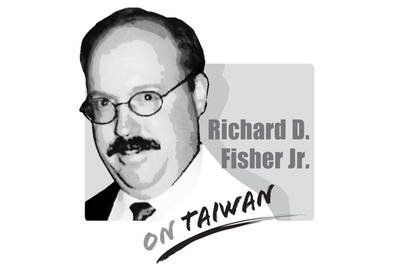The Executive Yuan said recently that it is planning to spend NT$9.2 billion (US$284 million) to build a second single-frequency network, to establish a platform for high-definition television (HDTV) technology and for digital video broadcasting.
The spending forms part of the nation's digitization project and will also set up four more digital TV channels and a digital database of TV programs. The program has become a topic of heated discussion among the ruling and opposition parties. However, we should consider whether the project will improve the development of the media and the rights of the general public.
The Cable TV household penetration rate in Taiwan is high, but market forces have limited impact on the industry, given the level of monopolization. Although the Government Information Office's (GIO's) move to revoke the operating licenses of seven cable TV channels had some impact, the government has yet to pursue comprehensive structural improvement.
Structural reform must cover at least three platforms: cable TV, terrestrial TV and satellite TV. Terrestrial TV in particular is a representation of a nation's mainstream culture. Many satellite TV channels are broadcast abroad, and a number of cable TV channels rely on foreign investment (some are suspected of using capital from China). Therefore, as the government pushes ahead with the digitization project and the public begins to gain greater access to a variety of TV channels, adjusting the structure of Taiwan's media and enhancing cultural awareness among the general public has become a matter of urgency.
The NT$9.2 billion project to create a second single-frequency network is part of the nation's hardware infrastructure directed at digitizing the terrestrial TV channels. When the first and second single-frequency networks are fully operational, broadcast bands can be reorganized, freeing up space for new free-to-air radio and TV channels. This will offset the current preponderance of cable TV stations and provide the public with more options in terms of prices, quality and content.
Why is it significant that the government is digitizing terrestrial TV services and giving the public more TV channels? In Taiwan, with the exception of the Public Television Service, which is mandated by law, cable TV is the sole preserve of commercial groups.
Therefore, the government's attempt to expand public broadcasting services over a digital terrestrial platform is intended to offer more high-quality content and provide more options for consumers.
I should emphasize here that the terrestrial digital TV channels we shall see in the future will lead to higher quality public broadcasting than we have at present, offering a wider range of services than are currently available, in addition to commercial TV channels.
The Public Broadcasting Act (
This will prevent these public groups from turning into money pits.
After all, the public has to pay cable operators for services that include free-to-air channels.
The new platform, when it is complete, will have succeeded in giving consumers more choices and improving services only if it also leads to lower prices -- such as a monthly fee of NT$100 per household and 30 quality HDTV channels with a variety of content.
Weng Shieu-chi is a professor in the department of journalism at National Chengchi University.
TRANSLATED DANIEL CHENG AND PAUL COOPER
On Sunday, 13 new urgent care centers (UCC) officially began operations across the six special municipalities. The purpose of the centers — which are open from 8am to midnight on Sundays and national holidays — is to reduce congestion in hospital emergency rooms, especially during the nine-day Lunar New Year holiday next year. It remains to be seen how effective these centers would be. For one, it is difficult for people to judge for themselves whether their condition warrants visiting a major hospital or a UCC — long-term public education and health promotions are necessary. Second, many emergency departments acknowledge
US President Donald Trump’s seemingly throwaway “Taiwan is Taiwan” statement has been appearing in headlines all over the media. Although it appears to have been made in passing, the comment nevertheless reveals something about Trump’s views and his understanding of Taiwan’s situation. In line with the Taiwan Relations Act, the US and Taiwan enjoy unofficial, but close economic, cultural and national defense ties. They lack official diplomatic relations, but maintain a partnership based on shared democratic values and strategic alignment. Excluding China, Taiwan maintains a level of diplomatic relations, official or otherwise, with many nations worldwide. It can be said that

Victory in conflict requires mastery of two “balances”: First, the balance of power, and second, the balance of error, or making sure that you do not make the most mistakes, thus helping your enemy’s victory. The Chinese Communist Party (CCP) has made a decisive and potentially fatal error by making an enemy of the Jewish Nation, centered today in the State of Israel but historically one of the great civilizations extending back at least 3,000 years. Mind you, no Israeli leader has ever publicly declared that “China is our enemy,” but on October 28, 2025, self-described Chinese People’s Armed Police (PAP) propaganda
Chinese Nationalist Party (KMT) Chairwoman Cheng Li-wun (鄭麗文) made the astonishing assertion during an interview with Germany’s Deutsche Welle, published on Friday last week, that Russian President Vladimir Putin is not a dictator. She also essentially absolved Putin of blame for initiating the war in Ukraine. Commentators have since listed the reasons that Cheng’s assertion was not only absurd, but bordered on dangerous. Her claim is certainly absurd to the extent that there is no need to discuss the substance of it: It would be far more useful to assess what drove her to make the point and stick so